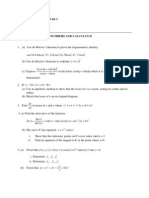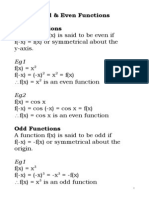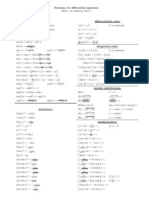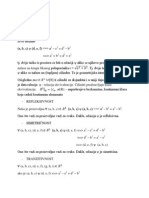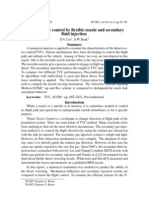Fourier Series
Fourier Series
Uploaded by
PurushothamanCopyright:
Available Formats
Fourier Series
Fourier Series
Uploaded by
PurushothamanOriginal Description:
Copyright
Available Formats
Share this document
Did you find this document useful?
Is this content inappropriate?
Copyright:
Available Formats
Fourier Series
Fourier Series
Uploaded by
PurushothamanCopyright:
Available Formats
Chapter 12: Orthogonal Functions and Fourier Series
Orthogonal Functions
1, 2 1 2
( ) ( ) ( ) ( ) 0
b
a
f f f x f x w x dx = =
}
:
1, 2
f f
[ , ] a b
Orthogonal
ex)
2 3
1 2
( ) , ( ) f x x f x x = =
interval
[ 1,1]
1
1
1 2 3 6
1, 2
6
1 1
( ) 0 f f x x dx x
= = =
}
Orthogonal with w(x)=1
Orthogonal Sets
( , ) ( ) ( ) ( ) 0,
b
m n m n
a
x x w x dx m n | | | | = = =
}
, where
( ) w x
: weight function
2
2
( ) ( ) ( )
b
n n
a
x w x x dx | | =
}
and
2
( ) ( ) ( ) .
b
n n
a
x w x x dx | | =
}
If
{ ( )}
n
x |
,
2
( ) 1, 0, 1, 2,
n
x n | = =
Orthonormal Set
Example 1 Orthogonal Set of Functions
{ } { }
| |
0 0
cos
( , ) 1 ( ) ( ) cos
1
sin
1
sin sin( ) 0, 0
n
n n
nx
x x dx nxdx
nx
n
n n n
n
t t
t t
t
t
|
| | | |
t t
=
= =
=
= = =
} }
| |
cos
( , ) ( ) ( ) 1 cos cos
1
2
1 sin( ) sin( )
0,
( ) cos( ) trig ident
2
ity
m n m n
m
x x dx mx nxd
n x m n x
x
dx
m n x m n x
m n
m n m n
t t
t t
t
t
t
t
| | | |
= =
=
+
(
= + = =
(
+
+ +
} }
}
orthogonal [, ] with = 1
Norms
2
0
( ) 1 2 x dx
t
t
| t
= =
}
0
( ) 2 . x | t =
| |
2
2
1
( ) cos 1 cos 2
2
n
x nxdx nx dx
t t
t t
| t
= = + =
} }
( ) .
n
x | t =
1 cos cos 2
, , ,
2
x x
t t t
`
)
Orthonormal set
Why do we need this orthogonal set? Series expansion!
Weve learnt power series;
=
0
+
1
+
2
2
+ =
=0
()
!
Analogously, we can expand , , , an orthogonal set
{
0
,
1
,
2
, }
=
0
0
+
1
1
+ +
+ =
=0
()
In many cases, these expansions are found to be very useful!
Taylor series!
power
Orthogonal Series Expansion
0 0 1 1
0
( ) ( ) ( ) ( ) ( ) ?
n n n n
n
f x c x c x c x c x | | | |
=
= = + + + +
0 0 1 1
0 0 1 1
( ) ( ) ( ) ( ) ( ) ( ) ( ) ( ) ( )
( ) ( ) ( )
( , ) ( , ) ( , ) .
b b b
m m m
a a a
b
n n m
a
m m n n m
f x x w x dx c x x w x dx c x x w x dx
c x x w x dx
c c c
| | | | |
| |
| | | | | |
= + +
+ +
= + + + +
} } }
}
2
( ) ( ) ( ) ( ) ( ) .
b b
n n n
a a
f x x w x dx c x w x dx | | =
} }
2
2
( ) ( ) ( ) ( ) ( ) ( )
( )
(
, 0
) ( )
,1, 2, .
b b
n n
a a
n b
n
n
a
f x x w x dx f x x w x dx
c
x
x w x dx
n
| |
|
|
= = =
} }
}
2
0 0
( , )
( ) ( ) ( )
( )
n
n n n
n n
n
f
f x c x x
x
|
| |
|
= =
= =
Fourier Series
Introduction
0 1 2
{ ( ), ( ), ( ), } x x x | | |
Orthogonal Set
0 0 1 1
0
( ) ( ) ( ) ( ) ( )
n n n n
n
f x c x c x c x c x | | | |
=
= = + + + +
Trigonometric Series
2 3
1, cos , cos , cos ,
2 3
sin , sin , sin ,
x x x
p p p
x x x
p p p
t t t
t t t
`
)
`
)
Orthogonal with
( ) 1 w x =
on
[ , ] p p
(1)
0
1
( ) cos sin .
2
n n
n
a n n
f x a x b x
p p
t t
=
| |
= + +
|
\ .
(2)
0
1
( ) cos sin .
2
p p p p
n n
p p p p
n
a n n
f x dx dx a xdx b xdx
p p
t t
=
| |
= + +
|
\ .
} } } }
= 0 = 0
0 0
0
( )
2 2
p
p p
p p
p
a a
f x dx dx x pa
= = =
} }
0
1
( ) .
p
p
a f x dx
p
=
}
cos( / ) m x p t
0
1
( ) cos cos
2
cos cos cos sin .
p p
p p
p p
n n
p p
n
a m m
f x xdx xdx
p p
m n m n
a x xdx b x xdx
p p p p
t t
t t t t
=
=
| |
+ +
|
\ .
} }
} }
cos 0, 0, cos sin 0
p p
p p
m m n
xdx m x xdx
p p p
t t t
= > =
} }
0,
cos cos
, .
p
p
m n
m n
x xdx
p m n p p
t t
}
( ) cos
p
n
p
n
f x xdx a p
p
t
=
}
cos
2
=
1+cos 2
2
1
( ) cos .
p
n
p
n
a f x xdx
p p
t
=
}
sin( / ) m x p t
sin 0, 0, sin cos 0
p p
p p
m m n
xdx m x xdx
p p p
t t t
= > =
} }
0,
sin sin
, ,
p
p
m n
m n
x xdx
p m n p p
t t
}
1
( )sin .
p
n
p
n
b f x xdx
p p
t
=
}
Fourier Series
0
1
( ) cos sin ,
2
n n
n
a n n
f x a x b x
p p
t t
=
| |
= + +
|
\ .
0
1
( )
p
p
a f x dx
p
=
}
1
( ) cos
p
n
p
n
a f x xdx
p p
t
=
}
1
( )sin .
p
n
p
n
b f x xdx
p p
t
=
}
Example 1 Expansion in a Fourier Series
0, - 0
( ) , ( ) 1
, 0
x
f x p w x
x x
t
t
t t
< <
= = =
< <
2
0
0
0
0
0
0
0
0
0
2
1 1 1
( ) 0 ( )
2 2
1 1
( ) cos 0 ( ) cos
1 sin 1
( ) sin
1 cos
cos 1
cos ( 1)
n
n
x
a f x dx dx x dx x
a f x nxdx dx x nxdx
nx
x nxdx
n n
nx
n n
n
n
n
t
t t
t t
t t
t t
t
t
t
t
t
t t
t t t
t
t t
t
t
t
t
t
(
(
= = + = =
(
(
(
= = +
(
(
=
+
(
(
=
=
+
=
} } }
} } }
}
2
1 ( 1)
.
n
n t
=
0
1 1
( )sin .
n
b x nxdx
n
t
t
t
= =
}
=
4
+
=1
1 (1)
cos +
1
sin
Periodic Extension
2 3 2 3
1, cos , cos , cos , , sin , sin , sin , x x x x x x
p p p p p p
t t t t t t
`
)
(1)
( ) ( ) f x T f x + =
(0 ) (0 )
2 2
f f t + +
=
and
( ) ( )
0,
2
f f t t + +
=
Sequence of Partial Sums
1
( )
4
S x
t
=
2
2
( ) cos sin
4
S x x x
t
t
= + +
3
2 1
( ) cos sin sin 2
4 2
S x x x x
t
t
= + + +
Fourier Cosine and Sine Series
Review
Even Function:
( ) ( ) f x f x =
Odd Function:
( ) ( ) f x f x =
Even and Odd Functions
even integer
2
( ) f x x
+
=
:
2 2
( ) ( ) ( ) f x x x f x = = =
odd integer
3
( ) f x x
+
=
:
3 3
( ) ( ) ( ). f x x x f x = = =
cos( ) cos x x =
: Even Function
sin( ) sin x x =
: Odd Function
Properties
Properties of Even/Odd Functions
(a) Two even function even
(b) Two odd function even
(c) An even function and an odd function odd
(d) Sum (difference) of two even function even
(e) Sum (difference) of two odd function odd
(f)
( ) f x
is even
0
( ) 2 ( )
a a
a
f x dx f x dx
=
} }
(g)
( ) f x
is odd
( ) 0
a
a
f x dx
=
}
Proof of (b)
( ), ( ) f x g x
is odd
( ) ( ), ( ) ( ) f x f x g x g x = =
( ) ( ) ( ) F x f x g x
( ) ( ) ( ) ( ( ))( ( )) ( ) ( ) ( ). F x f x g x f x g x f x g x F x = = = =
Cosine and Sine Series
( ) f x
is
[ , ] p p
even
0
0
1 2
( ) ( )
p p
p
a f x dx f x dx
p p
= =
} }
0
1 2
( ) cos ( ) co
even
s
p p
n
p
n n
a f x x dx f x xdx
p p p p
t t
= =
} }
odd
1
( )sin 0
p
n
p
n
b f x x dx
p p
t
= =
}
( ) f x
is
[ , ] p p
odd
0
2
0, 0,1, 2, , ( )sin .
p
n n
n
a n b f x xdx
p p
t
= = =
}
Example Expansion in a Sine Series
1, 0
( )
1, 0
x
f x
x
t
t
< <
s <
( , ) t t
odd function Sine Series
0
2 2 1 ( 1)
(1)sin ,
n
n
b nxdx
n
t
t t
= =
}
1
2 1 ( 1)
( ) sin .
n
n
f x nx
n t
=
=
(7)
Sturm-Liouville Problem: An extension of orthogonality
| |
( ) ( ( ) ( )) 0
d
r x y q x p x y
dx
' + + =
in the interval | | , a b
(3)
| | ( ) & ( ) 0 in the interval , Assume r x p x a b >
1 1
( ) ( ) 0 A y a B y a ' + =
(4)
2 2
( ) ( ) 0 A y b B y b ' + =
(5) (Homogeneous Problem)
Example 1 Eigenvalues and Eigenfunctions
0, (0) 0, ( ) 0 y y y y L '' ' ' + = = =
(2)
0: sin cos , (0) 0 A 0 y A x B x y ' > = + = =
'( ) sin 0 y L B L L n t = = =
2 2 2
1
/ , 0,1, 2, 3, , cos( / )
n
n L n y c n x L t t = = =
B.Cs:
eigenvalue
( ) ( ) 1,
( ) 0
p x r x
q x
= =
=
) = 0 =
1
+
2
,
1
= 0,
2
= 0
From
0 =
= 0 trivial!
) < 0 : = cosh + sin A=B=0
From
0 =
= 0 trivial!
Similarly, in Sturm-Liouville problem,
we can set
, a eigenvalue set!
for each
, only one eigenfunction,
exists:
ex)
= cos
for
=
2
2
Each eigenfunction is linearly independent
This set of
eigenfunctions are orthogonal with = ()!
Properties of the Regular Sturm-Liouville Problem
for two eigenvalue
, ,
m n m n
y y
: eigenfunctions
| |
( ) ( ( ) ( )) 0
m m m
d
r x y q x p x y
dx
' + + =
(6)
| |
( ) ( ( ) ( )) 0
n n n
d
r x y q x p x y
dx
' + + =
(7)
(6) (7)
n m
y y
| | | |
( ) ( ) ( ) ( ) .
m n m n m n n m
d d
p x y y y r x y y r x y
dx dx
' ' =
Integrating x a = to x b =
| |
( ) ( )
= ( )
( ) ( ) ( ) ( ) ( ) (
b b b
b b
m n m n m n m n n m n m
a a
a a a
b
m n n m
a
m n n m
p x y y dx y r y ry y dx y r y ry y dx
r y y y y
r b y b y b y b y b r a
( (
' ' ' ' ' ' =
( (
' '
' ' =
} } }
| | ) ( ) ( ) ( ) ( )
m n n m
y a y a y a y a ' '
(8)
From B.Cs
+
1
= 0 (1)
+
1
= 0 (2)
1
=
0
0
if (1) & (2) linearly independent,
1
=
1
= 0 trivial
(= )
1
&
1
,
det
= 0
= 0
()
()
()
() = 0
Similarly,
+
2
= 0 (1)
+
2
= 0 (2)
= 0
(
= 0, if orthogonal
Example 2 A Regular Sturm-Liouville Problem
0, (0) 0, (1) (1) 0. y y y y y '' ' + = = + =
(10)
( ) 1, ( ) 1, ( ) 0 r x p x q x = = =
Solution
1) 0 =
Trivial Solution
2)
2
0 o = <
Trivial Solution
3)
2
0 o = >
2
0 y y o '' + =
1 2
cos sin y c x c x o o = +
1
0 c =
,
2 2
sin cos 0. c c o o o + =
tano o =
Then,
= sin
, where tan
This set is orthogonal!
Example 3 Bessel Equation: in cylindrical coordinate!
| |
2 2
2 2
'' ' 0 or ' 0,
n d n
xy y x y xy x y
x dx x
o o
| | | |
+ + = + =
| |
\ . \ .
1 2
( ) ( )
n n
y c J x c Y x o o = +
2
2
( ) , ( ) , , ( )
n
r x x p x x q x
x
o = = = =
(0) 0 (0) , only ( ) is bounded at 0!!
n n
r Y J x x o = =
A set { ( )} is orthogonal with respect to ( ) ( ) on an interval [0, ]!
n i
J x w x p x b o =
0
( ) ( ) 0, ,
b
n i n j i j
xJ x J x dx o o = =
}
'
2 2
( ) ( ) 0. * B.C.
n n
A J b B J b Homogeneous o o o + =
We do not need homogeneous B.C. at 0, because (0) 0! x r = =
Legendres Equation: frequently found in spherical coordinate
2
(1 ) " 2 ( 1) 0 x y xy n n y + + =
2
(1 ) ' ( 1) 0.
d
x y n n y
dx
( + + =
(21)
2
2
( ) 1 , ( ) 1, ( 1), ( ) 0
( ) 1 ( 1) (1) 0!
r x x p x n n q x
r x x r r
= = = + =
= = =
On the interval [-1,1],
1
1
( ) ( ) 0, .
m n
P x P x dx m n
= =
}
orthogonal with w(x)=1
Regardless of B.C.s at
1 & 1 x x = =
Fourier-Bessel Series
For an interval [0,b], B.C. at x=b,
'
2 2
( ) ( ) 0.
n n
A J b B J b o o o + =
1
( ) ( ),
i n i
i
f x c J x o
=
=
0
2
( ) ( )
.
( )
b
n i
i
n i
xJ x f x dx
c
J x
o
o
=
}
2
2
0
( ) ( ) .
b
n i n i
J x xJ x dx o o =
}
Square Norm
| | | | ( )
2
2 2 2 2
' 0 2 ' ' 2 ' 0
d n d
xy x y xy xy yy x n
dx x dx
o o
| |
+ = + =
|
\ .
by
2 ' xy
| | ( ) | |
2 2
2 2 2
' 0.
d d
xy x n y
dx dx
o + =
| | ( )
( )
2
2 2 2 2 2 2
0
0
2 '
b
b
xy dx xy x n y o o = +
}
( )| |
2
2
2 2 2 2 ' 2 2 2
0
2 ( ) ( ) ( ) ,
b
n n n
xJ x dx b J b b n J b o o o o o o ( = +
}
Now, check B.C. at = :
2
( ) +
2
( ) =
2
( ) +
2
( ) = 0
)
2
= 0,
( ) = 0
) = 0,
2
=
2
Since,
( ) =
( )
+1
( )
( ) =
( )
+1
( )
2
2
2
( ) = [
( )]
2
+ (
2
2
2
)[
( )]
2
Known value
=0
=0
+1
( )
2
(
) =
2
2
+1
2
(
)
)
2
= ,
2
= ,
( ) +
( ) = 0
( ) =
( )
2
2
0
2
( ) = [
( )]
2
+ (
2
2
2
)[
( )]
2
0
2
(
) =
1
2
2
(
2
2
+
2
)
2
(
) i=1,2,3
No 0!
=
( )
Ex) = , 0 < < 3 =
=1
1
(
),
1
( 3) = 0 . .
=
2
3
2
2
2
(3
)
0
3
) let t =
=
2
3
2
2
2
(3
)
1
3
0
3
1
( ) =
2
3
2
2
2
(3
)
2
2
( )
3
0
=
2
2
(3
1
( ) =
( )) , = 2
2
1
( ) =
(
2
2
( ))
w(x)
f(x)
[
2
= 1,
2
= 0, = 1, = 3]
=
=1
2
1
(
2
(3
)
Summary: Fourier-Bessel Series
1
( ) ( )
i n i
i
f x c J x o
=
=
2 2
0
1
2
( ) ( ) ,
( )
b
i n i
n i
c xJ x f x dx
b J b
o
o
+
=
}
1
( ) ( )
i n i
i
f x c J x o
=
=
2
2 2 2 2 2
0
2
( ) ( ) ,
( ) ( )
b
i
i n i
i n i
c xJ x f x dx
b n h J b
o
o
o o
=
+
}
1 0
2
( ) ( )
i i
i
f x c c J x o
=
= +
1 0
2 2 2
0 0
1
2 2
( ) , ( ) ( ) ,
( )
b b
i i
i
c xf x dx c xJ x f x dx
b b J b
o
o
= =
} }
:
( ) = 0
:
( ) +
( ) = 0
:
0
( ) = 0
Fourier-Legendre Series: on the interval [-1,1], w(x)=1
1
2
2
1
2
( ) ( ) .
2 1
n n
P x P x dx
n
= =
+
}
0
( ) ( ),
n n
n
f x c P x
=
=
1
1
2 1
( ) ( ) .
2
n n
n
c f x P x dx
+
=
}
Alternative Form of Series
In many cases in spherical coordinate, it is useful to let
0
( ) (cos )
n n
n
F c P u u
=
=
0
2 1
( ) (cos )sin ,
2
n n
n
c F P d
t
u u u u
+
=
}
Proof of this is quite tricky. We just accept this here.
= cos
= cos
= sin & 1,1 , 0
You might also like
- Cape Pure Mathematics Unit 2module 1: Complex Numbers and Calculus IiDocument20 pagesCape Pure Mathematics Unit 2module 1: Complex Numbers and Calculus IiCarlon BairdNo ratings yet
- 2.odd Even Function1Document12 pages2.odd Even Function1Atikah JNo ratings yet
- Maths FormulaDocument4 pagesMaths Formulamickey_disney93No ratings yet
- Info Booklet, Revised 2011Document27 pagesInfo Booklet, Revised 2011ordinanceNo ratings yet
- Formula2 (1) UpdatedDocument3 pagesFormula2 (1) UpdatedAmm RoehNo ratings yet
- Final Exam Set ADocument17 pagesFinal Exam Set AAtikah J100% (1)
- MA2211 NotesDocument145 pagesMA2211 NotesBala SubramanianNo ratings yet
- Final Formula SheetDocument3 pagesFinal Formula SheetwhatnononoNo ratings yet
- Fourier SeriesDocument31 pagesFourier SeriesSachi DhanandamNo ratings yet
- Math ReferenceDocument24 pagesMath ReferenceSujib BarmanNo ratings yet
- EE - 210 - Exam 3 - Spring - 2008Document26 pagesEE - 210 - Exam 3 - Spring - 2008doomachaleyNo ratings yet
- Misrimal Navajee Munoth Jain Engineering College, Chennai - 97Document26 pagesMisrimal Navajee Munoth Jain Engineering College, Chennai - 97bhagyagr8No ratings yet
- Advanced Computational Methods: Numerical IntegrationDocument59 pagesAdvanced Computational Methods: Numerical IntegrationMohammed HamdyNo ratings yet
- Fourier SeriesDocument11 pagesFourier SeriesJohnson Ken100% (1)
- Ath em Ati CS: L.K .SH Arm ADocument6 pagesAth em Ati CS: L.K .SH Arm APremNo ratings yet
- Ee602 Fourier SeriesDocument110 pagesEe602 Fourier SeriesArryshah DahmiaNo ratings yet
- Ath em Ati CS: L.K .SH Arm ADocument8 pagesAth em Ati CS: L.K .SH Arm APremNo ratings yet
- A FormulaDocument2 pagesA FormulaUmesh Rao H NNo ratings yet
- Multivariable Calculus, 2008-10-31. Per-Sverre Svendsen, Tel.035 - 167 615/0709 - 398 526Document5 pagesMultivariable Calculus, 2008-10-31. Per-Sverre Svendsen, Tel.035 - 167 615/0709 - 398 526lieth-4No ratings yet
- Answers 2009-10Document19 pagesAnswers 2009-10Yoga RasiahNo ratings yet
- Linearna Algebra - Rjesenja, ETFDocument44 pagesLinearna Algebra - Rjesenja, ETFmarkovukNo ratings yet
- Ath em Ati CS: L.K .SH Arm ADocument7 pagesAth em Ati CS: L.K .SH Arm APremNo ratings yet
- $RM3GFU6Document14 pages$RM3GFU6bacchuskevin10No ratings yet
- Advanced Engineering Mathematics Solutions (2-4 2-7&2-10)Document26 pagesAdvanced Engineering Mathematics Solutions (2-4 2-7&2-10)Fa VelizNo ratings yet
- Formulario: L Ogica Matem AticaDocument10 pagesFormulario: L Ogica Matem AticaDaniel ChuquipomaNo ratings yet
- Fourier SeriesDocument81 pagesFourier SeriesBunty PereraNo ratings yet
- 1910 Formula PacketDocument4 pages1910 Formula PacketJNo ratings yet
- L-6 de Series SolutionDocument88 pagesL-6 de Series SolutionRiju VaishNo ratings yet
- S R S S: Pearson's Sample Correlation CoefficientDocument1 pageS R S S: Pearson's Sample Correlation Coefficientgopinath_slNo ratings yet
- NYJC JC 2 H2 Maths 2011 Mid Year Exam Solutions Paper 1Document10 pagesNYJC JC 2 H2 Maths 2011 Mid Year Exam Solutions Paper 1jimmytanlimlongNo ratings yet
- Ux VX : Função Derivada Da Função Fórmulas de IntegraçãoDocument2 pagesUx VX : Função Derivada Da Função Fórmulas de IntegraçãoJosierBaiottoNo ratings yet
- Mathes 3 NotesDocument127 pagesMathes 3 NotesShashi Bhushan PatelNo ratings yet
- Ath em Ati CS: L.K .SH Arm ADocument10 pagesAth em Ati CS: L.K .SH Arm APremNo ratings yet
- Formula For TPDEDocument11 pagesFormula For TPDEGowtham Raj100% (2)
- Chpt05-FEM For 2D SolidsnewDocument56 pagesChpt05-FEM For 2D SolidsnewKrishna MyakalaNo ratings yet
- Rumus Matematika Sma InterDocument19 pagesRumus Matematika Sma InterAde JayusNo ratings yet
- BT2 Revision Package Solutions (2008 Prelims)Document111 pagesBT2 Revision Package Solutions (2008 Prelims)gerwynngNo ratings yet
- (A) If F (X) and G (X) Have Period P, Show That H (X) Af (X) + BG (X) (A, B, Constant)Document15 pages(A) If F (X) and G (X) Have Period P, Show That H (X) Af (X) + BG (X) (A, B, Constant)Heather JohnsonNo ratings yet
- EGM6341 Sol HW 01Document22 pagesEGM6341 Sol HW 01Redmond R. ShamshiriNo ratings yet
- Multivariable Calculus, 2007-03-15. Per-Sverre Svendsen, Tel.035 - 167 615/0709 - 398 526Document5 pagesMultivariable Calculus, 2007-03-15. Per-Sverre Svendsen, Tel.035 - 167 615/0709 - 398 526lieth-4No ratings yet
- Some Basic Formulae:: Quadratic FormulaDocument6 pagesSome Basic Formulae:: Quadratic FormulaBlazingStudiosNo ratings yet
- Exam - 2011 10 28Document5 pagesExam - 2011 10 28lieth-4No ratings yet
- Differentiation Cheat SheetDocument15 pagesDifferentiation Cheat SheetjieboNo ratings yet
- Uraian FourierDocument91 pagesUraian FourierAgus Dian PratamaNo ratings yet
- Appendix I: A. 2-DOF Barycenter Stabilization ModelDocument2 pagesAppendix I: A. 2-DOF Barycenter Stabilization Modelnchubccl100% (1)
- Integrals: Definitions Definite Integral: Suppose Anti-Derivative: An Anti-Derivative ofDocument5 pagesIntegrals: Definitions Definite Integral: Suppose Anti-Derivative: An Anti-Derivative ofuditagarwal1997No ratings yet
- F C D I: Jesús Rubí MirandaDocument2 pagesF C D I: Jesús Rubí Mirandalmarobesg94No ratings yet
- Bab 8 Transformasi Z - Oke2Document53 pagesBab 8 Transformasi Z - Oke2Zaky DarmawanNo ratings yet
- Engineering MathsDocument8 pagesEngineering MathsSanthosh SanNo ratings yet
- Trigonometric Ratios to Transformations (Trigonometry) Mathematics E-Book For Public ExamsFrom EverandTrigonometric Ratios to Transformations (Trigonometry) Mathematics E-Book For Public ExamsRating: 5 out of 5 stars5/5 (1)
- De Moiver's Theorem (Trigonometry) Mathematics Question BankFrom EverandDe Moiver's Theorem (Trigonometry) Mathematics Question BankNo ratings yet
- Analytic Geometry: Graphic Solutions Using Matlab LanguageFrom EverandAnalytic Geometry: Graphic Solutions Using Matlab LanguageNo ratings yet
- Inverse Trigonometric Functions (Trigonometry) Mathematics Question BankFrom EverandInverse Trigonometric Functions (Trigonometry) Mathematics Question BankNo ratings yet
- Transformation of Axes (Geometry) Mathematics Question BankFrom EverandTransformation of Axes (Geometry) Mathematics Question BankRating: 3 out of 5 stars3/5 (1)
- Mathematics 1St First Order Linear Differential Equations 2Nd Second Order Linear Differential Equations Laplace Fourier Bessel MathematicsFrom EverandMathematics 1St First Order Linear Differential Equations 2Nd Second Order Linear Differential Equations Laplace Fourier Bessel MathematicsNo ratings yet
- 10+2 Level Mathematics For All Exams GMAT, GRE, CAT, SAT, ACT, IIT JEE, WBJEE, ISI, CMI, RMO, INMO, KVPY Etc.From Everand10+2 Level Mathematics For All Exams GMAT, GRE, CAT, SAT, ACT, IIT JEE, WBJEE, ISI, CMI, RMO, INMO, KVPY Etc.No ratings yet
- Aircraft PropulsionDocument33 pagesAircraft PropulsionPurushothamanNo ratings yet
- Propulsion Question Bank: Dr. Purushothaman Nandagopalan August 2019Document8 pagesPropulsion Question Bank: Dr. Purushothaman Nandagopalan August 2019PurushothamanNo ratings yet
- Sustainable Engineering Question BankDocument10 pagesSustainable Engineering Question BankPurushothamanNo ratings yet
- How To Get Your Cetificates Apostilled in South KoreaDocument8 pagesHow To Get Your Cetificates Apostilled in South KoreaPurushothamanNo ratings yet
- Polymer PhysicsDocument405 pagesPolymer PhysicsPurushothaman100% (6)
- Curve FittingDocument86 pagesCurve FittingPurushothamanNo ratings yet
- Ambur Chicken BiryaniDocument3 pagesAmbur Chicken BiryaniPurushothamanNo ratings yet
- Von Karman Lecture SeriesDocument2 pagesVon Karman Lecture SeriesPurushothamanNo ratings yet
- DSMC-PIC Analysis of A Plume From A Small Ion Engine: 2001 by Michio Nishida. Published by The ElecDocument8 pagesDSMC-PIC Analysis of A Plume From A Small Ion Engine: 2001 by Michio Nishida. Published by The ElecPurushothamanNo ratings yet
- Everynth Operations Skipping RowsDocument2 pagesEverynth Operations Skipping RowsPurushothamanNo ratings yet
- Navier-Stokes/Direct Simulation Monte Carlo Modeling of Small Cold Gas Thruster Nozzle and Plume FlowsDocument103 pagesNavier-Stokes/Direct Simulation Monte Carlo Modeling of Small Cold Gas Thruster Nozzle and Plume FlowsPurushothamanNo ratings yet
- Thrust Vector Control by Flexible Nozzle and Secondary Fluid InjectionDocument10 pagesThrust Vector Control by Flexible Nozzle and Secondary Fluid InjectionPurushothamanNo ratings yet
- Chapter 5, Question 5: Rocket EquationDocument3 pagesChapter 5, Question 5: Rocket EquationPurushothamanNo ratings yet
